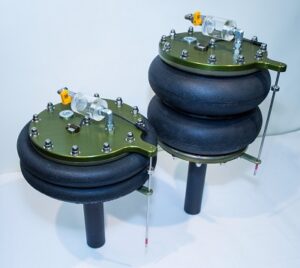Variable-volume reservoirs (VVRs) are compact hydraulic reservoirs that can often replace conventional hydraulic reservoirs, with benefits to users that include lighter weight, smaller size and lower costs, as well as addressing potential safety, oil contamination and environmental issues. They’re similar to bootstrap-type reservoirs that have been used for decades in aerospace applications.

A variable-volume reservoir like the 7-liter VVR 400 from Smart Reservoir can replace conventional hydraulic oil reservoirs that are 40 times larger.
In a classic vented reservoir, fluid level rises and falls when a hydraulic cylinder in the circuit retracts or extends. As the rod extends outside air is pulled in through the reservoir breather, likely ingesting particles and moisture. Air is pushed out as the rod retracts.
On the other hand, a hydraulic circuit with a VVR has the same cylinder actions, but a rubber bellows on the reservoir expands and contracts as the rod moves back and forth. Differential volume in the reservoir equals the rod volume, plus a bit to account for thermal expansion.
Thus, only the cylinder rod volume must be taken into account when sizing the reservoir (in addition to the network fluid volume expansion). Fluid enters or leaves the VVR only when there is the need for compensation during cylinder motion and/or thermal changes. Otherwise, the returning flow goes directly to the pump inlet. Using the VVR is similar to having a hydrostatic, closed-loop system except that the VVR can be used with multiple pumps and multiple actuators.
As a result, the reservoir can be much smaller than traditional ones. On selected applications, they can replace conventional hydraulic oil reservoirs that are 40 times larger, according to engineers at Smart Reservoir, Bois-des-Filion, Quebec. And that has a significant bearing on costs. For example, filling a classic 150 l reservoir with $6/l mineral oil, versus a 7 l VVR that offers the same circuit performance, would cost $858 more.
Standard Variable Volume Reservoirs developed by Smart Reservoir range in size from 2.5 l (0.7 gal) to 21.5 l (5.7 gal) displacement, and the company also offers models where volume can be customized. A sizing calculator is available on the company’s web site.
The Smart Reservoir VVR is sealed, airless and slightly pressurized (1 to 9 psi/0.1 to 0.6 bar). Therefore, the VVR dramatically reduces the ingestion of solid contaminants and oxidation-producing moisture. Experts say this could increase fluid life by up to five times versus oil used in conventional reservoirs. The VVR maintains a relatively constant pressure at pump inlets, supercharging the pumps and reducing the possibility of cavitation, regardless of the operating altitude and orientation of the reservoir. Unlike gas accumulators, the pressurization is generated mechanically by a spring and will not be affected by temperature or ambient pressure.
One VVR can feed multiple pumps or one per pump to isolate circuits. Multiple VVR’s can be installed in series or parallel to increase volume requirements. And a VVR can be used on new equipment or retrofitted to existing systems.
They operate in a temperature range of -20° to 107°C (-4° to 225°F). With the reduced volume, in cold start situations the warm-up time will be much quicker. An optional heater pad can be installed for operating at temperatures below -20⁰C.
A related issue is fluid cooling. Many hydraulic systems, according to Smart Reservoir engineers, are currently designed with oversized reservoirs as they are believed to act as oil coolers. Conventional reservoirs do cool oil, but minimally. A properly sized air/oil or water/oil type heat exchanger can keep system temperature within the desired range regardless of the environment and offer a better solution to cooling fluid.
Due to the small volume of oil, a VVR system will quickly stop in the event of a leak — a feature to help avoid serious environmental damage. If a hose bursts or a seal fails, cleanup is less involved and costly when compared with a 250-liter conventional reservoir. And a contactless switch installed on top of the VVR can be used to trigger an alarm or engine kill-switch if the oil level runs low to avoid any system damage.
The VVR bellows also offers a healthy margin of safety. The bellows is designed to withstand pressures of up to 300 psi yet operates at a pressure of 9 psi or less. Pressure in the return line is modest as well. A VVR can be fitted with an overboard relief valve that will open at 15 psi in the event of a malfunction. This works as a fuse and protects other components in the network. Note, however, that a VVR is not designed to replace an accumulator.
Smart Reservoir
www.variablevolumereservoir.com
Filed Under: News, Reservoirs